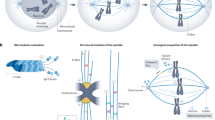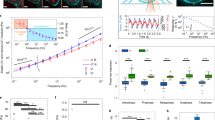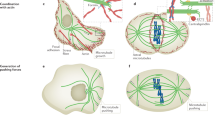Abstract
In creating the mitotic spindle and the contractile ring, natural selection has engineered fascinating precision machines whose movements depend upon forces generated by ensembles of cytoskeletal proteins. These machines segregate chromosomes and divide the cell with high fidelity. Current research on the mechanisms and regulation of spindle morphogenesis, chromosome motility and cytokinesis emphasizes how ensembles of dynamic cytoskeletal polymers and multiple motors cooperate to generate the forces that guide the cell through mitosis and cytokinesis.
This is a preview of subscription content, access via your institution
Access options
Subscribe to this journal
Receive 51 print issues and online access
$199.00 per year
only $3.90 per issue
Buy this article
- Purchase on Springer Link
- Instant access to full article PDF
Prices may be subject to local taxes which are calculated during checkout


Similar content being viewed by others
References
Harris, H. The Birth of the Cell (Yale Univ. Press, New Haven, 1999).
Mitchison, T. J. & Salmon, E. D. Mitosis: a history of division. Nature Cell Biol. 3, E17–E22 (2001).
Wood, K. W., Cornwell, W. D. & Jackson, J. R. Past and future of the mitotic spindle as an oncology target. Curr. Opin. Pharmacol. 1, 370–377 (2001).
Sharp, D. J., Rogers, G. C. & Scholey, J. M. Microtubule motors in mitosis. Nature 407, 41–47 (2000).
Karsenti, E. & Vernos, I. The mitotic spindle, a self-made machine. Science 294, 543–547 (2001).
Wittman, T., Hyman, A. & Desai, A. The spindle, a dynamic assembly of microtubules and motors. Nature Cell Biol. 3, E28–E34 (2001).
Scholey, J. M. & Mogilner, A. in Molecular Motors (ed. Schliwa, M.) 327–355 (Wiley-VCH, Weinheim, 2003).
Kapoor, T. M. & Compton, D. A. Searching for the middle ground: mechanisms of chromosome alignment during mitosis. J. Cell Biol. 157, 551–556 (2002).
McIntosh, J. R., Grishunk, E. L. & West, R. R. Chromosome-microtubule interactions during mitosis. Annu. Rev. Cell Dev. Biol. 18, 193–219 (2002).
Shah, J. V. & Cleveland, D. W. Waiting for anaphase: Mad2 and the spindle assembly checkpoint. Cell 103, 997–1000 (2000).
Glotzer, M. Animal cell cytokinesis. Annu. Rev. Cell Dev. Biol. 17, 351–386 (2001).
Gonczy, P. et al. Functional genomic analysis of cell division in C. elegans using RNAi of genes on chromosome III. Nature 408, 331–336 (2000).
Bray, D. Cell Movements(Garland, New York, 2001).
Howard, J. Mechanics of Motor Proteins and the Cytoskeleton (Sinauer, Sunderland, MA, 2001).
Nicklas, R. B. Measurements of the force produced by the mitotic spindle in anaphase. J. Cell Biol. 97, 542–548 (1983).
Rappaport, R. Cell division: direct measurement of maximum tension exerted by furrow of echinoderm eggs. Science 156, 1241–1243 (1967).
Burton, K. & Taylor, D. L. Traction forces of cytokinesis measured with optically modified elastic substrata. Nature 385, 450–454 (1997).
Gunawardane, R. N., Lizarraga, S. B., Wiese, C., Wilde, A. & Zheng, Y. Gamma-tubulin complexes and their role in microtubule nucleation. Curr. Top. Dev. Biol. 49, 55–73 (2000).
Moritz, M., Braunfeld, M. B., Guenebaut, V., Heuser, J. & Agard, D. A. Structure of the γ-tubulin ring complex: a template for microtubule nucleation. Nature Cell Biol. 2, 365–370 (2000).
Keating, T. J. & Borisy, G. G. Immunostructural evidence for the template mechanism of microtubule nucleation. Nature Cell Biol. 2, 352–357 (2000).
Erickson, H. P. γ-tubulin nucleation: template or protofilament? Nature Cell Biol. 2, E93–E96 (2000).
Popov, A. V., Severin, F. & Karsenti, E. XMAP215 is required for the microtubule-nucleating activity of centrosomes. Curr. Biol. 12, 1326–1330 (2002).
Kalab, P., Weis, K. & Heald, R. Visualization of a Ran-GTP gradient in interphase and mitotic Xenopus egg extracts. Science 295, 2452–2456 (2002).
Walczak, C. E. Ran hits the ground running. Nature Cell Biol. 3, E1–E3 (2001).
Theurkauf, W. E. TACCing down the spindle poles. Nature Cell Biol. 3, E159–E161 (2001).
Walczak, C. E., Vernos, I., Mitchison, T. J., Karsenti, E. & Heald, R. Model for the proposed roles of different microtubule based motor proteins in establishing spindle bipolarity. Curr. Biol. 8, 903 (1998).
Brust-Mascher, I. & Scholey, J. M. Microtubule flux and sliding in mitotic spindles of early Drosophila embryos. Mol. Biol. Cell 13, 3967–3975 (2002).
Nedelec, F. Computer simulations reveal motor properties generating stable antiparallel microtubule interactions. J. Cell Biol. 158, 1005–1015 (2002).
Kapoor, T. M. & Mitchison, T. J. Eg5 is static in bipolar spindles relative to tubulin: evidence for a static spindle matrix. J. Cell Biol. 154, 1125–1133 (2001).
Wells, W. A. Searching for a spindle matrix. J. Cell Biol. 154, 1102–1104 (2001).
Wigge, P. A. et al. Analysis of the Saccharomyces spindle pole by matrix assisted laser desorption/ionization (MALDI) mass spectroscopy. J. Cell Biol. 141, 967–977 (1998).
Mack, G. J. & Compton, D. A. Analysis of mitotic microtubule-associated proteins using mass spectrometry identifies astrin, a spindle-associated protein. Proc. Natl Acad. Sci. USA 98, 14434–14439 (2001).
Kinoshita, K., Arnal, I., Desai, A., Drechsel, D. N. & Hyman, A. A. Reconstitution of physiological microtubule dynamics using purified components. Science 294, 1340–1343 (2001).
Heald, R. A dynamic duo of microtubule regulators. Nature Cell Biol. 2, E11–E12 (1999).
Severin, F., Haberman, B., Huffaker, T. & Hyman, A. A. Stu2 promotes mitotic spindle elongation in anaphase. J. Cell Biol. 153, 435–442 (2001).
Ostergren, G. The mechanism of co-orientation in bivalents and multivalents. The theory of orientation by pulling. Hereditas 37, 85–156 (1951).
Cytrynbaum, E., Scholey, J. M. & Mogilner, A. Force-balance model for early spindle pole separation in Drosophila embryonic mitotic spindles. Biophys. J. 84, 757–769 (2003).
Holy, T. E. & Leibler, S. Dynamic instability of microtubules as an efficient way to search in space. Proc. Natl Acad. Sci. USA 91, 5682–5685 (1994).
Alexander, S. P. & Rieder, C. L. Chromosome motion during attachment to the vertebrate spindle: initial saltatory-like behavior of chromosomes and quantitative analysis of force production by nascent kinetochore fibers. J. Cell Biol. 113, 805–815 (1991).
Skibbens, R. V., Skeen, V. P. & Salmon, E. D. Directional instability of kinetochore motility during chromosome congression and segregation in mitotic newt lung cells: a push-pull mechanism. J. Cell Biol. 122, 859–875 (1993).
Sharp, D. J., Rogers, G. C. & Scholey, J. M. Cytoplasmic dynein is required for poleward chromosome movement in Drosophila embryos. Nature Cell Biol. 2, 922–930 (2000).
Yucel, J. K. et al. CENP-meta, an essential kinetochore kinesin required for the maintenance of metaphase chromosome alignment in Drosophila. J. Cell Biol. 150, 1–12 (2000).
Maddox, P., Desai, A., Oegema, K., Mitchison, T. J. & Salmon, E. D. Poleward microtubule flux is a major component of spindle dynamics and anaphase A in mitotic Drosophila embryos. Curr. Biol. 12, 1670–1674 (2002).
Joglekar, A. P. & Hunt, A. J. A simple, mechanistic model for directional instability during mitotic chromosome movements. Biophys J. 83, 42–58 (2002).
Levesque, A. A. & Compton, D. A. The chromokinesin Kid is necessary for chromosome arm orientation and oscillation, but not congression, on mitotic spindles. J. Cell Biol. 154, 1135–46 (2001).
Maney, T., Ginkel, L. M., Hunter, A. W. & Wordeman, L. The kinetochore of higher eucaryotes: a molecular view. Int. Rev. Cytol. 194, 67–131 (2000).
Desai, A., Verma, S., Mitchison, T. J. & Walczak, C. E. Kin-I kinesins are microtubule-destabilizing enzymes. Cell 96, 69–78 (1999).
Nasmyth, K., Peters, J. M. & Uhlmann, F. Splitting the chromosome: cutting the ties that bind sister chromatids. Science 288, 1379–1384 (2000).
Funabiki, H. & Murray, A. W. The Xenopus chromokinesin, Xkid is essential for metaphase chromosome alignment and must be degraded to allow anaphase chromosome movement. Cell 102, 411–424 (2000).
Marshall, W. F., Marko, J. F., Agard, D. A. & Sedat, J. W. Chromosome elasticity and mitotic polar ejection force measured in living Drosophila embryos by four-dimensional microscopy-based motion analysis. Curr. Biol. 11, 569–578 (2001).
Zhou, J., Yao, J. & Yoshi, H. C. Attachment and tension in the spindle assembly checkpoint. J. Cell Sci. 115, 3547–3555 (2002).
Howell, B. J., Hoffman, D. B., Fang, G., Murray, A. W. & Salmon, E. D. Visualization of Mad2 dynamics at kinetochores, along spindle fibers, and at spindle poles in living cells. J. Cell Biol. 150, 1233–1250 (2000).
Li, X. & Nicklas, R. B. Tension-sensitive kinetochore phosphorylation and the chromosome distribution checkpoint in praying mantid spermatocytes. J. Cell Sci. 110, 537–545 (1997).
Hoffman, D. B., Pearson, C. G., Yen, T. J., Howell, B. J. & Salmon, E. D. Microtubule-dependent changes in assembly of microtubule motor proteins and mitotic spindle checkpoint proteins at PtK1 kinetochores. Mol. Biol. Cell 12, 1995–2009 (2001).
Howell, B. J. et al. Cytoplasmic dynein/dynactin drives kinetochore protein transport to the spindle poles and has a role in mitotic spindle checkpoint inactivation. J. Cell Biol. 155, 1159–1172 (2001).
Chan, G. K. T., Jablonski, S. A., Starr, D. A., Goldberg, M. L. & Yen, T. J. Human Zw10 and ROD are mitotic checkpoint proteins that bind to kinetochores. Nature Cell Biol. 2, 944–947 (2000).
Wojcik, E. et al. Kinetochore dynein: its dynamics and role in the transport of the Rough deal checkpoint protein. Nature Cell Biol. 3, 1001–1008 (2001).
Abrieu, A., Kahana, J. A., Wood, K. W. & Cleveland, D. W. Cenp-E as an essential component of the mitotic checkpoint in vitro. Cell 102, 817–826 (2000).
Nicklas, R. B., Waters, J. C., Salmon, E. D. & Ward, S. C. Checkpoint signals in grasshopper meiosis are sensitive to microtubule attachment but tension is still essential. J. Cell Sci. 114, 4173–4183 (2001).
Skoufias, D. A., Andreassen, P. R., Lacroix, F. B., Wilson, L. & Margolis, R. L. Mammalian mad2 and bub1/bubR1 recognize distinct spindle-attachment and kinetochore-tension checkpoints. Proc. Natl Acad. Sci. USA 98, 4492–4497 (2001).
Shannon, K. B., Canman, J. C. & Salmon, E. D. Mad2 and BubR1 function in a single checkpoint pathway that responds to a loss of tension. Mol. Biol. Cell 10.1091/mbc.E02-03-0137 (2002).
Zhou, J., Panda, D., Landen, J. W., Wilson, L. & Joshi, H. C. Minor alteration of microtubule dynamics causes loss of tension across kinetochore pairs and activates the spindle checkpoint. J. Biol. Chem. 277, 17200–17208 (2002).
Beaudouin, J., Gerlich, D., Daigle, N., Eils, R. & Ellenberg, J. Nuclear envelope breakdown proceeds by microtubule-induced tearing of the lamina. Cell 108, 83–96 (2002).
Reinsch, S. & Gonczy, P. Mechanisms of nuclear positioning. J. Cell Sci. 111, 2283–2295 (1998).
Grill, S. W., Gonczy, P., Stelzer, E. H. & Hyman, A. Polarity controls forces governing asymmetric spindle positioning in the C. elegans embryo. Nature 409, 630–633 (2001).
Rappaport, R. Cytokinesis in Animal Cells (Cambridge Univ. Press, Cambridge, 1996).
Cao, L. G. & Wang, Y. L. Mechanism of the formation of contractile ring in dividing cultured animal cells. I. Recruitment of preexisting actin filaments into the cleavage furrow. J. Cell Biol. 110, 1089–1095 (1990).
Wang, Y. L. The mechanism of cytokinesis: reconsideration and reconciliation. Cell Struct. Funct. 26, 633–638 (2001).
Bi, G. Q. et al. Kinesin- and myosin-driven steps of vesicle recruitment for Ca2+ regulated exocytosis. J. Cell Biol. 138, 999–1008 (1997).
Shuster, C. B & Burgess, D. R. Targeted new membrane addition in the cleavage furrow is a late, separate event in cytokinesis. Proc. Natl Acad. Sci. USA 99, 3633–3638 (2002).
Robinson, D. N. & Spudich, J. A. Towards a molecular understanding of cytokinesis. Trends Cell Biol. 10, 228–237 (2000).
Somma, M. P., Fasulo, B., Cenci, G., Cundari, E. & Gatti, M. Molecular dissection of cytokinesis by RNA interference in Drosophila cultured cells. Mol. Biol. Cell 13, 2448–2460 (2002).
Satterwhite, L. L. & Pollard, T. D. Cytokinesis. Curr. Opin. Cell Biol. 4, 43–52 (1992).
Guertin, D. A., Trautmann, S. & McCollum, D. Cytokinesis in eukaryotes. Microbiol. Mol. Biol. Rev. 66, 155–178 (2002).
Robinson, D. N., Cavet, G., Warrick, H. M. & Spudich, J. A. Quantitation of the distribution and flux of myosin-II during cytokinesis. BMC Cell Biol. 3, 4–16 (2002).
Finger, F. P. & White, J. G. Fusion and fission: membrane trafficking in animal cytokinesis. Cell 108, 727–730 (2002).
Liu, B. & Lee, Y.-R. Kinesin-related proteins in plant cytokinesis. J. Plant Growth Regul. 20, 141–150 (2001).
Moller-Jensen, J., Jensen, R. B., Lowe, J. & Gerdes, K. Prokaryotic DNA segregation by an actin-like filament. EMBO J. 21, 3119–3127 (2002).
Purcell, E. Life at low Reynolds number. Am. J. Phys. 45, 3–11 (1977).
Acknowledgements
Supported by the National Institutes of Health.
Author information
Authors and Affiliations
Corresponding author
Rights and permissions
About this article
Cite this article
Scholey, J., Brust-Mascher, I. & Mogilner, A. Cell division. Nature 422, 746–752 (2003). https://doi.org/10.1038/nature01599
Issue Date:
DOI: https://doi.org/10.1038/nature01599
This article is cited by
-
Molecular Engineering to Achieve AIE-active Fluorophore with Near-infrared (NIR) Emission and Temperature-sensitive Property
Journal of Fluorescence (2023)
-
In vitro assembly, positioning and contraction of a division ring in minimal cells
Nature Communications (2022)
-
Comparison of microtubules stabilized with the anticancer drugs cevipabulin and paclitaxel
Polymer Journal (2020)
-
Triple A patient cells suffering from mitotic defects fail to localize PGRMC1 to mitotic kinetochore fibers
Cell Division (2018)
-
Mitotic cells generate protrusive extracellular forces to divide in three-dimensional microenvironments
Nature Physics (2018)
Comments
By submitting a comment you agree to abide by our Terms and Community Guidelines. If you find something abusive or that does not comply with our terms or guidelines please flag it as inappropriate.



